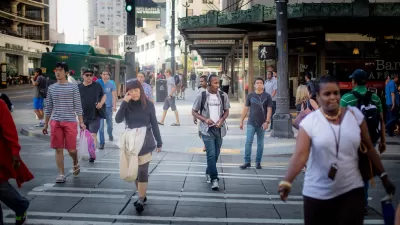Proof from the Census Bureau's latest American Community Survey on commuting by auto shows that millennials, if they live in cities, do indeed drive less. Census researcher Brian McKenzie describes the finding in the bureau's blog, Random Samplings.

The August 13 survey, "Who Drives to Work? Commuting by Automobile in the United States: 2013," and referenced here, has 28 pages (PDF) of data to pore over. However, a quick read can be found in Brian McKenzie's blog.
"Some of the most notable recent changes in commuting have occurred among younger workers, particularly those living in cities," writes McKenzie, also the author of the Census Bureau report.
- In 2013, about 74 percent of workers ages 16 to 24 living in principal cities commuted by automobile, compared with about 80 percent of the oldest workers.
- Workers between the ages of 25 and 29 living in principal cities showed the largest auto commuting declines since 2006, at about 4 percentage points. [See interpretation by Emily Badger below]. This is also the group that was least likely to have a vehicle at home in 2013.
By one definition, "the Millennial cohort consist(s) of individuals born between 1982 and 2004. Google defines a millennial as "a person reaching young adulthood around the year 2000; a Generation Yer."
For more data, go to the survey, page 6: DIFFERENCES IN AUTOMOBILE COMMUTING BY AGE (PDF)
Rapidly evolving transportation options and changing demographics across communities raise several questions about current and future travel patterns. Young people show some deviation from several long-standing travel-related indicators, including higher rates of commuting by travel modes other than private vehicles... To what extent these deviations may become a sustained pattern remains unclear.
McKenzie's work is meticulously footnoted, including references to a U.S. PIRG report posted here.
Writing in The Washington Post Wonkblog, Emily Badger emphasizes that the decline in auto commuting among millennials applies to those "who live in the principle city of each metropolitan area — so, not the suburbs."
A four-point decline [see second bullet above] may not sound like much (it means about 76.7 percent of these young urban workers still commute by car). But since 2006, the rate of their decline in driving is about four times greater than the national average. And, as the [below] chart shows, changes in commuting patterns happen gradually over many years.
Census Bureau: Figure 3, Random Samplings
FULL STORY: Majority of Americans Drive to Work, But Less so for Urban Millennials

Alabama: Trump Terminates Settlements for Black Communities Harmed By Raw Sewage
Trump deemed the landmark civil rights agreement “illegal DEI and environmental justice policy.”

Planetizen Federal Action Tracker
A weekly monitor of how Trump’s orders and actions are impacting planners and planning in America.

How Atlanta Built 7,000 Housing Units in 3 Years
The city’s comprehensive, neighborhood-focused housing strategy focuses on identifying properties and land that can be repurposed for housing and encouraging development in underserved neighborhoods.

In Both Crashes and Crime, Public Transportation is Far Safer than Driving
Contrary to popular assumptions, public transportation has far lower crash and crime rates than automobile travel. For safer communities, improve and encourage transit travel.

Report: Zoning Reforms Should Complement Nashville’s Ambitious Transit Plan
Without reform, restrictive zoning codes will limit the impact of the city’s planned transit expansion and could exclude some of the residents who depend on transit the most.

Judge Orders Release of Frozen IRA, IIJA Funding
The decision is a victory for environmental groups who charged that freezing funds for critical infrastructure and disaster response programs caused “real and irreparable harm” to communities.
Urban Design for Planners 1: Software Tools
This six-course series explores essential urban design concepts using open source software and equips planners with the tools they need to participate fully in the urban design process.
Planning for Universal Design
Learn the tools for implementing Universal Design in planning regulations.
Jessamine County Fiscal Court
Caltrans
Institute for Housing and Urban Development Studies (IHS)
City of Grandview
Harvard GSD Executive Education
Toledo-Lucas County Plan Commissions
Salt Lake City
NYU Wagner Graduate School of Public Service





























